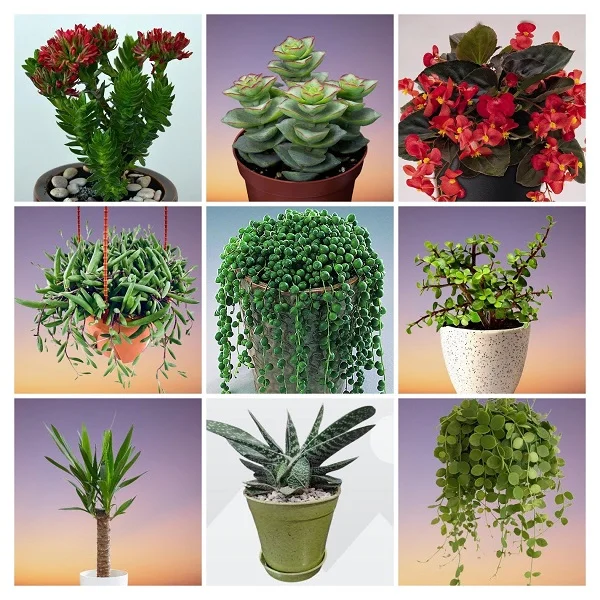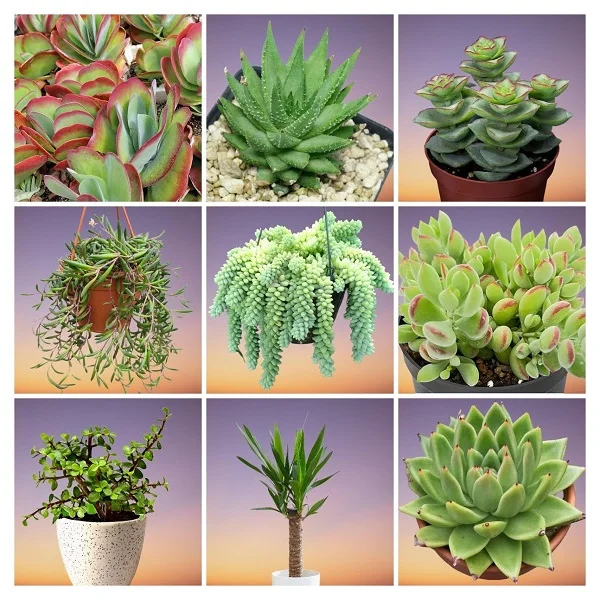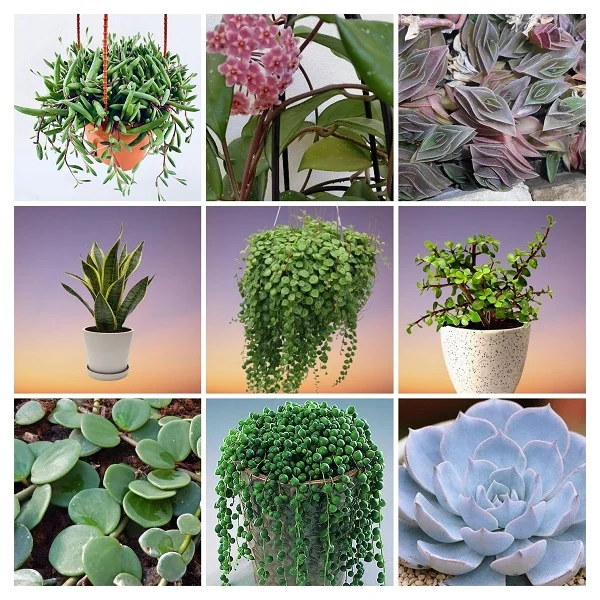36 Drought-tolerant Plants with Names and Pictures
Some links in this post may be affiliate links
Plants with little water needs do not require to be watered very frequently, they are drought tolerant and are perfect for the forgetful or busy plant parent.
The watering requirements for these plants is the 'soak and dry' method which involves a thorough watering followed by a period of dryness.
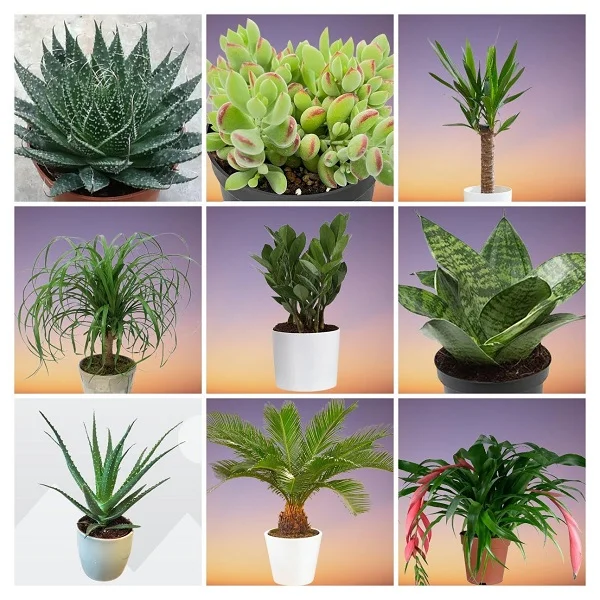
The drought-tolerant plants are watered liberally until the water comes out through the drainage hole when the top half of soil has dried out completely.
These plants that don't need much water are endowed with special structures which store water and allow them to go for considerable periods of time without being watered.
These special structures include modified leaves, stems and root systems which is an adaptation of these plants to their drought-prone natural environments.
36 Plants that Do Not Need Much Water to Thrive
Drought-tolerant plants include String of Nickels Plant, Burro's Tail Plant, String of Pearls Plant, Ponytail Palm, Felt Bush, Snake Plants, Bear's Paw Succulent among others.
1. String of Nickels Plant (Dischidia nummularia)
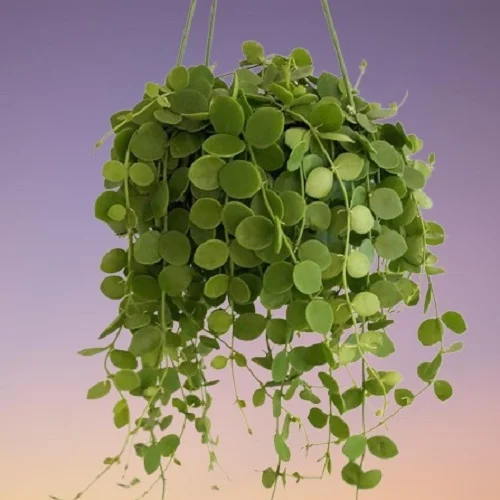
String of Nickels Plant also called Button Orchid is a trailing succulent plant which forms a dense mass of succulent, greenish-yellow, round leaves which look-like numerous coins, hence the common name.
The succulent leaves in Dischidia nummularia enable the plant to go for long periods of time without much water unlike its relatives Dischidia ovata and Dischidia ruscifolia.
Button Orchid requires bright light with some morning sunshine, average warmth and moderately moist, rich, well-drained soil.
Read more on how to grow and care for String of Nickels Plant
2. Burro's Tail Plant (Sedum morganianum)
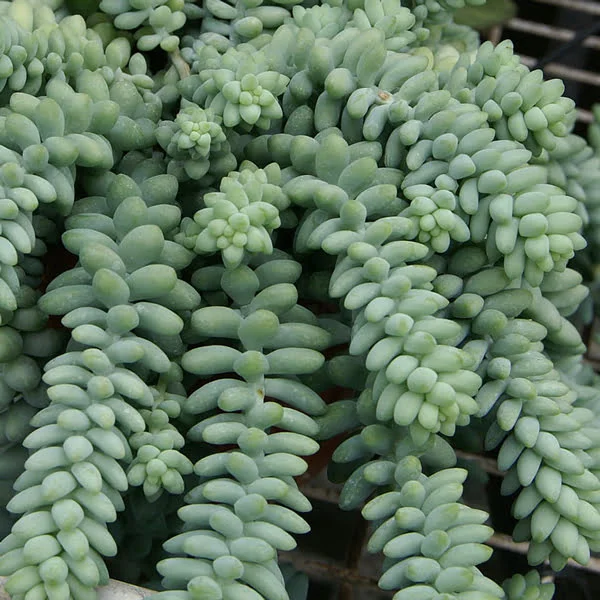
Burro's Tail Plant or Donkey's Tail Plant is a trailing plant which bears 2-3 ft long stems, completely clothed with blue-green, cylindrical, succulent leaves which store water.
The spectacular cascading stems and the terminal, pink to red flowers, make Donkey's Tail Plant ideal for a hanging basket, a pedestal or a table-top.
Sedum morganianum thrives in bright light with some direct sunshine, average warmth and moderately moist, fertile, loose, Cactus and Succulents soil.
3. String of Pearls Plant (Senecio rowleyanus)
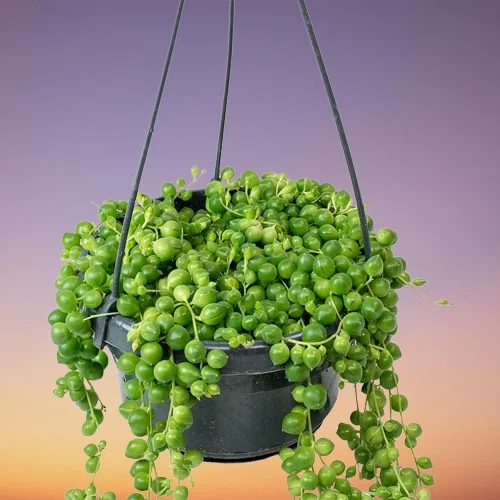
String of Pearls Plant or String of Beads Plant is one of the popular Senecio plants varieties with pendant thread-like stems on which spherical green leaves grow and it resembles a neck-lace of beads or pearls.
The odd shaped leaves in String of Beads Plant like in String of Lemons Plant (Senecio citriformis), String of Bananas Plant (Senecio radicans), String of Watermelons Plant (Senecio herreanus), String of Dolphins Plant (Senecio peregrinus) and Blue Chalksticks Plant (Senecio serpens) is an adaptation to arid conditions and allows for the storage of water while exposing minimum surface area to the dry desert air. This allows these plants to survive a considerably long period without being watered.
Senecio rowleyanus flourishes in bright light with 6-8 hours of direct sunlight, warmth of 20-270C, humidity of 50-55% and moderately moist, fertile, well-drained succulents potting mix coupled with monthly feeding in the growing season.
Read more on how to grow and care for String of Pearls Plant
4. Ponytail Palm (Beaucarnea recurvata)
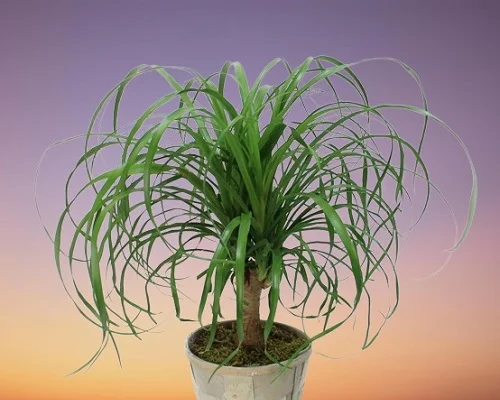
Ponytail Palm also called Elephant Foot does not require a lot of water due to the presence of the large, swollen bulb which stores water.
The large swollen bulb resembles an elephant's foot, hence, the common name 'Elephant Foot' while the plume of long strap-like leaves give this plant its common name 'Ponytail Palm'.
Beaucarnea recurvata requires bright light with 6-8 hours of direct sunlight, average warmth and moderately moist, rich, well-drained soil.
5. Felt Bush (Kalanchoe beharensis)
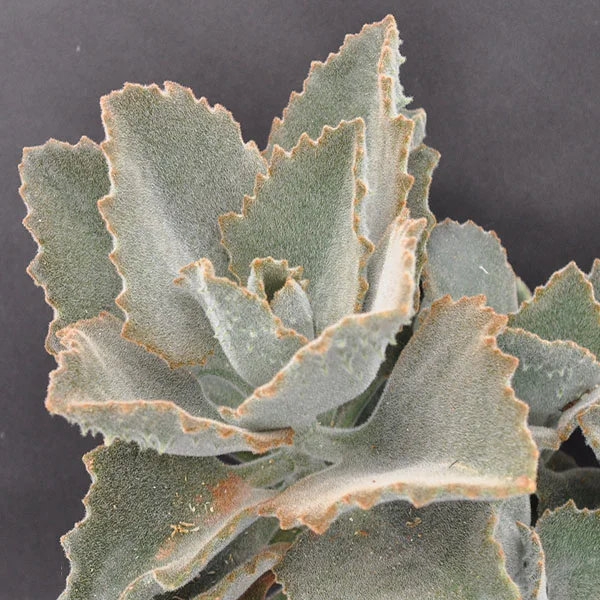
Felt Bush also called Elephant's Ear Kalanchoe or Velvet Elephant Ear is among the popular Kalanchoe varieties and is grown for its large, fleshy, velvety foliage which is covered by brown hairs.
On account of its succulent foliage which stores water thus enabling the plant to go for considerably long without being watered, Velvet Elephant Ear Plant and its cousins Kalanchoe blossfeldiana (Flaming Katy), Kalanchoe thyrsiflora (Paddle Plant) and Kalanchoe marmorata (Pen Wiper Plant) are some of the best drought tolerant plants that you can grow either indoors or outdoors.
Kalanchoe beharensis blossoms in bright light to full sunlight, warmth of 16-260C, humidity of 50-55% and moderately moist, fertile, well-drained succulents potting soil with monthly feeding during the growing season.
Learn more on how to grow and care for Felt Bush
6. Snake Plants (Dracaena trifasciata)

Snake Plant also called Mother in-law's Tongue is a popular plant for the home on account of its long beautifully colored, succulent foliage and ability to clean indoor air.
The Snake Plant Varieties are hard to kill plants which can withstand low light, dry air, draughts and periods without water but are prone to root-rot in soggy soil.
Dracaena trifasciata grows best in bright light with some direct sunlight, average warmth and moderately moist, loose, fertile, Cactus and Succulents soil.
Read more on how to grow and care for Snake Plants
7. Bear's Paw Succulent (Cotyledon tomentosa)

Bear's Paw Succulent also called Bear Claw Succulent or Cat Paw Succulent is a succulent, evergreen shrub which bears large, chunky, ovate, fuzzy, light-green leaves.
The chunky leaves reminiscent in Cotyledon Plants like Cotyledon pendens and Cotyledon campanulata store a lot of water which allows the plants to grow with minimal water requirements.
Cotyledon tomentosa thrives in bright light with direct sunlight of at least 4-6 hours, average warmth and loose, fast draining soil that is low in organic matter.
8. Desert Cacti
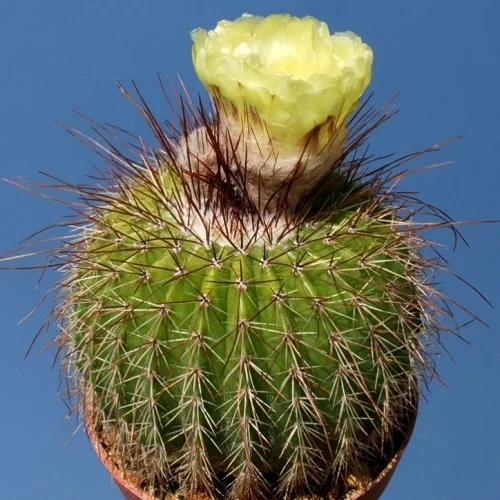
Desert Cactus come in numerous forms and sizes and they form interesting plants with specialized structures which enable them to tolerate drought conditions.
The native habitat of Cacti Plants is subject to drought as many live in extremely dry environments like the Atacama Desert with very bright sunshine.
Desert Cacti grow best in bright light to full sunlight with at least 6-8 hours of sunshine per day, average warmth and humidity and moderately moist, well drained soil.
9. Jade Plant (Crassula ovata)

Jade Plant is one of the popular Crassula plants varieties and bears succulent leaves and stems which store water and allow the plant to go for a considerably long periods without being watered.
Jade Plant like Crassula perforata (String of Buttons Plant), Crassula arborescens (Silver Dollar Jade), Crassula brevifolia (Crassula pearsonii) and Crassula capitella 'Campfire' is best watered by the 'soak and dry' method which requires a thorough soaking of the soil followed by a drying out of the soil before the next watering. They are some of best drought tolerant plants.
Crassula ovata thrives in bright light with 4-6 hours of direct sunlight, warmth of 15-260C , humidity of 50-55% and moderately moist, rich, well-drained succulents potting mix coupled with monthly feeding during the growing season.
Read more on how to grow and care for Jade Plant
10. Haworthia Plants

Haworthia Plants have firm, tough, fleshy leaves, usually dark-green in color while others are softer and contain leaf windows with translucent panels through which sunlight can reach internal photosynthetic tissues.
The fleshy leaves in Haworthia Plants form a rosette and store water which enables these plants to withstand periods of drought.
Haworthia require bright light with 4-6 hours of direct sunlight, average to above average warmth and moderately moist, fertile, succulents soil.
Learn more on how to grow and care for Haworthia Plants
11. Tree Houseleeks (Aeoniums)
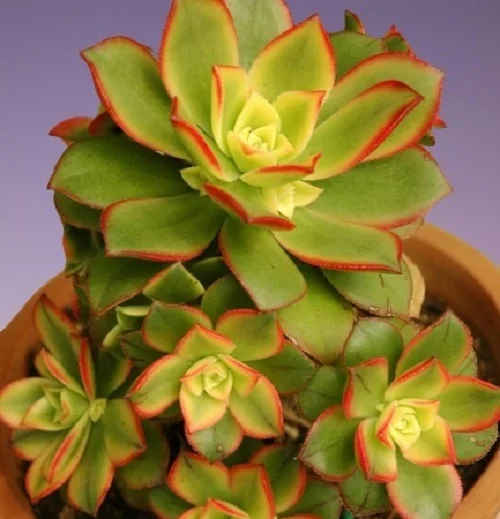
Aeoniums commonly called Tree Houseleeks bear succulent, glossy, spoon-shaped leaves which are typically arranged on a basal stem in a dense spreading rosette and can be low-growing plants or can be large trees.
The Aeonium Plants have a small root system as they store water in their succulent leaves which makes them highly prone to root-rot if overwatered, therefore, they do not require frequent watering.
Aeoniums grow best in bright light with some direct sunlight, average warmth and moderately moist, fertile, sandy loam soil.
12. Spineless Yucca (Yucca gigantea)

Spineless Yucca also called Blue-stem Yucca, Giant Yucca or Yucca Cane bears a crown of long, leathery, strap-like, spineless leaves and white bell-shaped flowers may appear on mature plants.
Blue-stem Yucca is a hardy plant which can grow in a variety of soils and is drought-tolerant as it stores water in its leaves.
Yucca gigantea thrives in very bright light with 4-6 hours of direct sunlight, average warmth and humidity and moderately moist, fertile succulent soil.
Read more on how to grow and care for Spineless Yucca
13. Houseleeks (Sempervivum)
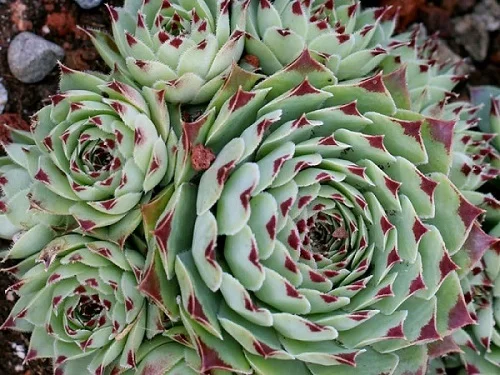
Houseleeks also called Liveforever or Hens and Chicks are popular, low-growing, succulent plants which stores in their leaves and allow the plants to adapt well to drought conditions
Sempervivums grow for several years before flowering afterwhich they die leaving many offsets, hence the common name, 'Liveforever'. These offsets have also given Houseleeks the common name, 'Hens and Chicks'.
Sempervivums require bright light with 6-8 hours of direct sunlight, average warmth and moderately moist, fertile, succulents soil.
Learn more on how to grow and care for Houseleeks
14. Aloe Plants
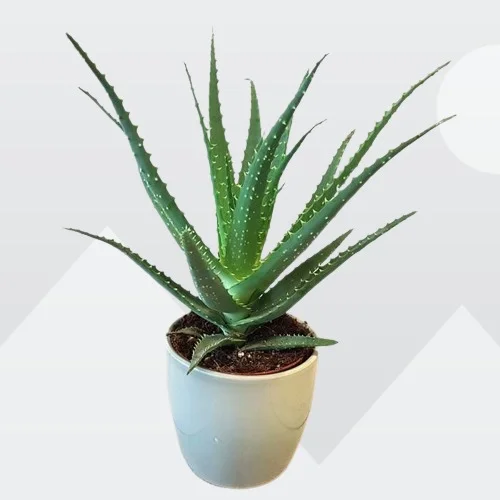
Aloe Plants are popular, succulent plants which come in all shapes and sizes. There are numerous species of Aloes but only a few are grown in the home.
Aloe Plants are native to tropical and southern Africa, Madagascar, Jordan, the Arabian Penisula and various islands in the Indian Ocean.
Aloe Plants grow best in bright light with 4-6 hours of direct sunlight, average warmth away from drafts and moderately moist, rich succulents soil.
15. Echeveria Plants
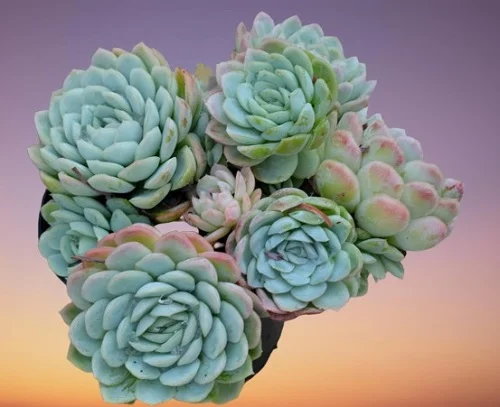
Echeveria Plants are low maintenance, easy to grow and propagate plants which form a rosette of short, beautiful and tightly packed succulent leaves which store water.
Echeveria Plants bear numerous offsets (pups) at the base of the plant which give the plants the name hen and chicks although this name may also refer to other genera like Sempervivum.
Echeveria Plants thrive bright light with 4-6 hours of direct sunlight, average warmth and moderately moist, well-drained soil.
Learn more on how to grow and care for Echeveria Plants
16. Thread Agave (Agave filifera)
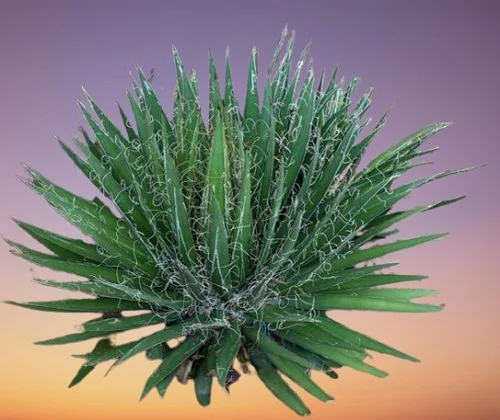
Thread Agave also called Thread-leaf Agave is popular, evergreen, perennial plant which forms a beautiful, stemless rosette of long, blade-like, dark-green to a bronzish-green colored, succulent leaves.
The Thread-leaf Agave is a slow growing plant which does not require frequent watering as it stores water in the succulent leaves.
Agave filifera requires bright light with 6-8 hours of direct sunlight and moderately moist, well-drained soil that is rich in organic matter.
Read more on how to grow and care for Thread Agave
17. Teddy Bear Vine (Cyanotis kewensis)
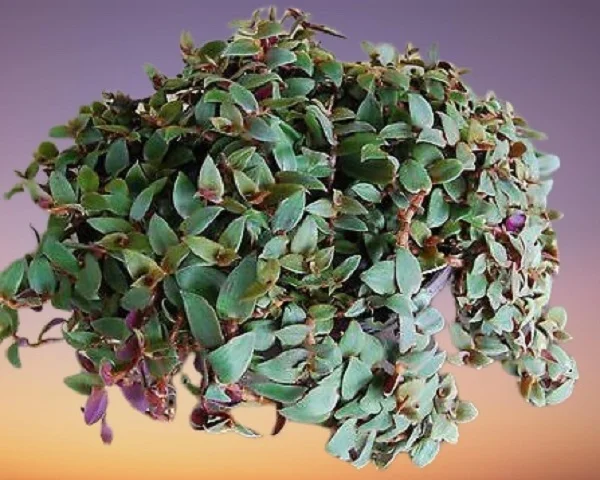
Teddy Bear Vine is a succulent vine with oval-shaped, hairy (velvet-like) leaves which thrives in drought conditions as it stores water in its leaves and stems.
The Teddy Bear Vine like its relative Cyanotis somaliensis bears stems which cascade downwards making it perfect for a hanging basket, a pedestal or a table-top.
Cyanotis kewensis thrives in bright indirect light with some morning sunshine, moderate warmth and humidity, moderately moist, rich, well-drained soils.
Learn more on how to grow and care for Teddy Bear Vine
18. String of Rubies Plant (Othonna capensis)
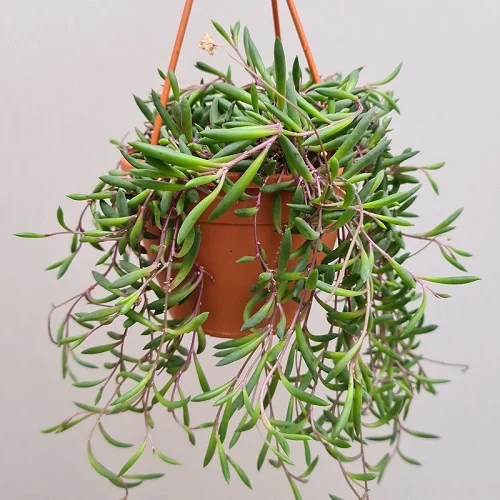
String of Rubies Plant also called String of Pickles, Little Pickles or Ruby Necklace bears reddish-purple stems and bean-shaped, succulent leaves which turn a bright ruby red when the plant is grown under bright sunshine.
The odd shaped leaves in String of Pickles Plant are an adaptation to drought conditions in its natural environment.
Othonna capensis grows best in very bright light, average warmth and moderately moist, fertile succulents soil.
Learn more on how to grow and care for String of Rubies Plant
19. Gasteria Plants
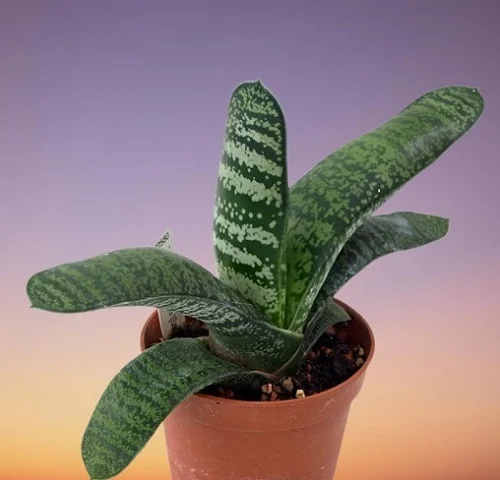
Gasteria Plants commonly called Ox-tongue, Cow-tongue, Lawyer's Tongue or occasionally Mother-in-law's Tongue bear thick, hard, succulent 'tongue-shaped' leaves which enable them to survive on little amounts of water.
The Gasteria Plants are mostly native to Eastern Cape Province of South Africa and extends into the far south-west corner of Namimbia and the Lebombo mountains of Swaziland.
Gasteria Plants thrive in bright light with some direct sunlight, average warmth and moderately moist, fertile succulents soil.
Learn more on how to grow and care for Gasteria Plants
20. Pearly Peperomia (Peperomia columella)
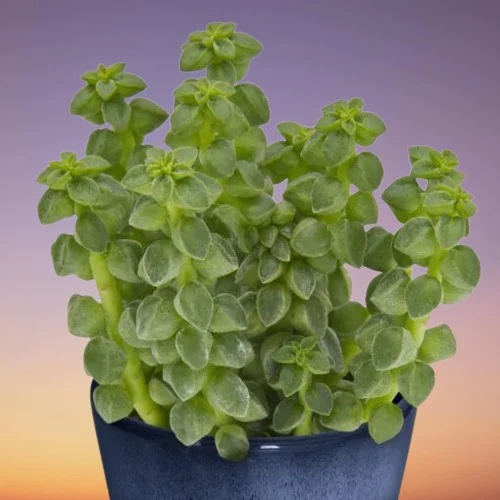
Pearly Peperomia also called Columnar Peperomia is among the popular Peperomia varieties and bears fleshy, upright stems from which arise tightly packed, alternately arranged, succulent leaves with transparent windows for light absoprtion and are also water storage structures.
Columnar Peperomia and its relatives Peperomia prostrata, Peperomia rotundifolia (Trailing Jade Plant), Peperomia angulata (Beetle Peperomia), Peperomia verticillata (Red Log Plant), Peperomia orba (Teardrop Peperomia) and Peperomia scandens 'Variegata' are drought-tolerant plants and are perfect for a hanging basket, pedestal, desktop or plant shelf where the stems can beautifully hang downwards.
Peperomia columella blossoms in bright indirect light (dappled light), warmth of 15-260C, humidity of 50-55% and moderately moist, fertile, well-drained succulents potting mix coupled with monthly feeding in the growing season.
Read more on how to grow and care for Pearly Peperomia
21. Jelly Beans Plant (Sedum rubrotinctum)

Jelly Beans Plant also commonly called Pork and Beans Plant bears short succulent leaves that resemble jelly beans and change color from green to red in bright light as a protective adaptation.
The succulent leaves in Pork and Beans Plant and its relative Sedum pachyphyllum store a lot of water which enables the plant to thrive even under drought conditions.
Jelly Beans Plant thrives in bright light to full sunlight, average warmth and moderately moist, fertile, loose, free-draining soil.
Read more on how to grow and care for Jelly Beans Plant
22. Moonstones Plant (Pachyphytum oviferum)

Moonstones Succulent or Sugar Almond Plant is a succulent plant with pale blue-green to bluish-purple, egg-shaped leaves which look-like a sugared almond confection and hence the name, 'Sugar Almond'.
The egg-shaped leaves in Sugar Almond Plant is an adapation of this plant to its natural habitat, the rocky cliffs of Mexico which enable it survive without much water.
Pachyphytum oviferum grows best in bright light to full sunlight away from hot direct sunlight, average warmth and moderately moist, well-drained soil.
Read more on how to grow and care for Moonstones Succulent
23. Trailing Jade Plant (Peperomia rotundifolia)

Trailing Jade Plant, Jade Necklace, Creeping Peperomia, Creeping Peperomia, Creeping Buttons and round Leaf Peperomia, is a trailing plant which bears very small, thick and fleshy, succulent and button-like leaves.
Creeping Peperomia is one of the popular Peperomia Plants that is ideal for a hanging basket or a table-top, where the stems can beautifully cascade downwards.
Peperomia rotundifolia thrives in medium to bright indirect light, warm and humid conditions and moderately moist, fertile, well-drained soil.
24. String of Hearts Plant (Ceropegia woodii)

String of Hearts Plant also called Rosary Vine, Chinese Lantern or Chain of Hearts is an unusual plant with succulent, heart-shaped leaves which helps it survive with little amounts of water.
Chain of Hearts Plant is one of the popular string of plants with spectacular leaves and trailing stems ideal for a hanging basket or a desk-top.
Ceropegia woodii grows best in bright indirect light, average warmth and moderately moist, rich, well-drained soil.
25. ZZ Plant (Zamioculcas zamiifolia)

ZZ Plant also called Zanzibar Gem, Zuzu Plant, Aroid Palm or Emerald Palm is a with attractive, glossy, succulent foliage which enables to be drought tolerant.
The foliage in Zanzibar Gem contains unusually high content of water up to 90% with which it can survive extremely well under interior low light levels for up to 4 months without water.
Zamioculcas zamiifolia thrives in bright indirect light, average warmth and moderately moist, fertile, free-draining soil.
Learn more on how to grow and care for ZZ Plant
26. Pig's Ear Plant (Cotyledon orbiculata)

Pig's Ear Plant also called Round-leafed Navel-wort, Silver Pig's Ears or Round-leafed Cotyledon bears grey-green leaves covered with a white powdery substance which helps them to reflect light and allows them to conserve water.
Silver Pig's Ears like Cotyledon velutina (Velvet Pig's Ears) bears leaves with a resemblance to a pig's ear, and hence the common name.
Cotyledon orbiculata requires very bright light to full sunlight, average warmth and moderately moist, rich, well-drained soil.
27. Sago Palm (Cycas revoluta)

Sago Palm also called King Sago, Sago Cycad, Japanese Sago Palm bears an attractive dark-green rosette of stiff arching foliage and a trunk characterized by a thick coat of fibers which enables it to survive drought.
Sago Cycad also called Cycas aurea or Cycas inermis is native to Southern Japan including Ryukyu Islands and grows best in sandy, well drained soil with some organic matter.
Cycas revoluta thrives in medium to bright light with 4-6 hours of direct sunlight, warmth of 18-270C, humidity of 50-55% and moderately moist, fertile, well-drained succulents potting soil coupled with monthly feeding during the growing season.
Read more on how to grow and care for Sago Palm
28. Cast Iron Plant (Aspidistra elatior)

Cast Iron Plant is a highly tolerant and extremely slow growing plant which can withstand periods of dryness at the roots if the temperature is not too high.
The Cast Iron Plant is one of the popular hard to kill plants which is very tolerant to shade and can withstand some level of neglect making it perfect for a beginner.
Aspidistra elatior grows best in bright light away from direct sunlight, average warmth and moderately moist, fertile, well-drained soil.
29. Madagascar Dragon Tree (Dracaena marginata)

Madagascar Dragon Tree is a tough, drought-resistant plant with aggressive root system and easily adapts to a wide range of indoor growing conditions and is also a good indoor air cleaner.
Madagascar Dragon Tree together with other Dracaena Plants are referred to as False palms due to their palm-like appearance of a leafless woody trunk on top of which is a crown of leaves.
Dracaena marginata thrives in bright indirect light away from direct sunlight, average warmth and moderately moist, rich, well-drained soil.
Learn more on how to grow and care for Madagascar Dragon Tree
30. Silver Crown Plant (Cotyledon undulata)

Silver Crown Plant also called Silver Ruffles Plant is a small succulent shrubby plant with unusual gray waxy-edged and bloom-covered leaves which help in conserving water.
The Silver Ruffles Plant is native to South Africa where they are found on coastal flats and rocky hillsides, or as cremnophytes on cliff faces.
Cotyledon undulata grows best in bright light to full sunlight, average warmth and moderately moist, fertile, well-drained soil.
Read more on how to grow and care for Silver Crown Plant
31. Queen's Tears Plant (Billbergia Bromeliads)

Queen's Tears Plant also called Friendship Plant is grown for the beauty of their drooping showy flower-heads and leathery, arching, long, grass-like leaves which allow it to thrive with little water.
Friendship Plant is one of the easy-care Bromeliad Varieties with a rosette of leathery, strap-like foliage and flower-head which arises on a stalk from the cup-like center of rosette.
Billbergia Bromeliads thrive in bright light away from direct sunlight, warm and humid conditions and moderately moist, rich well-drained soil.
Learn more on how to grow and care for Queen's Tears Plant
32. Chinese Money Plant (Pilea peperomioides)

Chinese Money Plant also called Missionary Plant, Pancake Plant, Friendship Plant or UFO Plant is an evergreen succulent plant which is drought tolerant.
The inflorescence in Missionary Plant is like that of Pilea cadierei (Aluminium Plant) while the leaves are like those of Coin-leaf Peperomia and hence the Botanical name, Pilea peperomioides.
Pilea peperomioides grows best in bright light away from direct sunlight, warm and moderately humid conditions and moderately moist, fertile, well-drained soil.
Read more on how to grow and care for Chinese Money Plant
33. Canary Island Date Palm (Phoenix canariensis)

Canary Island Date Palm also called Pineapple Palm is native to the Canary Islands and is a popular palm which is tolerant to soil variation and drought conditions.
Like other Palm Varieties, the spectacular Pineapple Palm is an elegant plant which will add a sophisticated and exotic feel in any space.
Phoenix canariensis thrives in bright indirect light, warm and humid conditions and moderately moist, well drained soil that is rich in organic matter.
Learn more on how to grow and care for Canary Island Date Palm
34. Lacy Tree Philodendron (Philodendron selloum)

Lacy Tree Philodendron also called Tree Philodendron or Splitleaf Philodendron bears simple, large, deeply lobed, ruffle-edged, glossy, dark-green leaves; a thick, woody, trunk and numerous aerial roots which allow it to survive on little water.
Splitleaf Philodendron like other Philodendron Plants is considered toxic to both humans and pets. Philodendron plants contain Calcium oxalate crystals which cause burning and swelling in the mouth and throat, vomiting, diarrhea and abdominal pains.
Philodendron selloum grows best in medium to bright indirect light away from direct sunlight, warm and humid conditions and moderately moist, fertile, well-drained soils.
Read more on how to grow and care for Lacy Tree Philodendron
35. Boat Lily (Tradescantia spathacea)

Boat Lily also called Moses-in-the-Cradle, Moses-in-a-Boat, Cradle Lily or Oyster Plant is among the popular Tradescantia varieties with fleshy, sword-shaped, glossy, green leaves with purplish-red undersides.
Oyster Plant fleshy leaves like those of its cousins Tradescantia navicularis (Chain Plant) and Tradescantia pallida (Purple Heart Plant) store water and allows these plants to go for considerably long periods without being watered which makes them easy to grow even for a beginner plant parent.
Tradescantia spathacea thrives in bright indirect light, warmth of 18-270C, humidity of 50-55% and moderately moist, fertile, well-drained soil coupled with monthly feeding during the growing season.
Learn more on how to grow and care for Boat Lily
36. Asparagus Fern (Asparagus plumosus)

Asparagus Fern also called Asparagus Grass, Lace Fern, Climbing Asparagus or Ferny Asparagus is among the popular ornamental Asparagus ferns with needle-like leaves and extensive root system which enables it to withstand drought conditions.
Asparagus Grass and its cousins Emerald Fern (Asparagus densiflorus 'Sprengeri'), Foxtail Fern (Asparagus densiflorus 'Meyeri'), Sicklethorn Fern (Asparagus falcatus) and Smilax Fern (Asparagus asparagoides) are not True Ferns and they easily adapt to wide variations in light, heat and frequency of watering.
Asparagus plumosus grows best in medium to bright indirect light, warmth of 16-280C, humidity of 50-55% and moderately moist, fertile, well-drained soils coupled with weekly feeding during the growing season.
Read more on how to grow and care for Asparagus Fern
